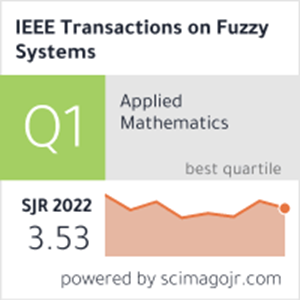GFS-node:节点预测图形模糊系统
IF 10.7
1区 计算机科学
Q1 COMPUTER SCIENCE, ARTIFICIAL INTELLIGENCE
引用次数: 0
摘要
由于确保模型可解释性和处理数据不确定性的挑战,图数据建模是非平凡的。虽然源自深度学习模型的方法,如图神经网络(gnn),能够处理图数据,但其可解释性是有限的。为了提高图数据的可解释性,人们提出了基于模糊规则和模糊推理的图模糊系统(gfs),但现有的方法只针对整个图的预测,而不能处理图数据建模中更常见的节点预测。为了解决这些问题,本文研究了一种用于节点预测的新型GFS (GFS-node)。为此,系统地发展了gfs节点的概念、框架和算法。首先,定义了节点模糊规则库、节点模糊集和节点后续处理模块等相关概念。在此基础上提出了gfs节点的一般框架,分析了模糊规则的前置词构造和结果。此外,还设计了gfs节点的具体实现方法。其中,提出了核K虚拟中心节点聚类(KVCN)算法来开发前置生成算法,采用线性消息传递网络(LMPN)来开发后继生成和学习算法。在多个基准数据集上进行了实验,结果表明GFS-node结合了传统模糊系统和经典gnn在节点预测方面的优点。本文章由计算机程序翻译,如有差异,请以英文原文为准。
GFS-Node: Graph Fuzzy Systems for Node Prediction
Graph data modeling is nontrivial due to the challenges to ensure model interpretability and handle data uncertainty. While methods derived from deep learning models, such as graph neural networks (GNNs), are able to handle graph data, the interpretability is limited. Graph fuzzy systems (GFSs) based on the fuzzy rules and fuzzy inference have been proposed to improve interpretability, but the existing methods are developed for whole graph prediction only and cannot deal with node prediction, which is a more common task in graph data modeling. To tackle the challenges, a novel GFS for node prediction (GFS-node) is investigated in this study. For this purpose, the concepts, framework, and algorithms of GFS-node are systematically developed. First, several related concepts are defined, including the node fuzzy rule base, node fuzzy set, and node consequent processing module (NCPM). A general framework for GFS-node is then presented, where the construction of antecedents and the consequents of fuzzy rules are analyzed. Furthermore, a concrete implementation method of GFS-node is designed. In particular, the kernel
K
virtual central nodes clustering (KVCN) algorithm is proposed to develop the algorithm for antecedent generation, and the linear message passing network (LMPN) is adopted to develop the algorithm for consequent generation and learning. Experiments are carried out on multiple benchmark datasets, and the results show that GFS-node combines the advantages of both traditional fuzzy systems and classical GNNs for node prediction.
求助全文
通过发布文献求助,成功后即可免费获取论文全文。
去求助
来源期刊

IEEE Transactions on Fuzzy Systems
工程技术-工程:电子与电气
CiteScore
20.50
自引率
13.40%
发文量
517
审稿时长
3.0 months
期刊介绍:
The IEEE Transactions on Fuzzy Systems is a scholarly journal that focuses on the theory, design, and application of fuzzy systems. It aims to publish high-quality technical papers that contribute significant technical knowledge and exploratory developments in the field of fuzzy systems. The journal particularly emphasizes engineering systems and scientific applications. In addition to research articles, the Transactions also includes a letters section featuring current information, comments, and rebuttals related to published papers.
 求助内容:
求助内容: 应助结果提醒方式:
应助结果提醒方式:


